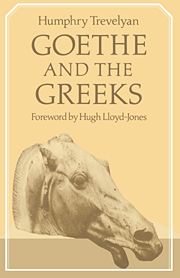CHAPTER III - WEIMAR
Published online by Cambridge University Press: 15 December 2009
Summary
Das Land der Griechen mit der Seele suchend.
It is customary to regard Goethe's arrival in Weimar in November 1775 as marking the end of his Sturm und Drang and the beginning of that period of self-discipline and repose which led eventually to the Italian journey and to classicism. Such sharp dividing lines between the periods of development in a human being are inevitably no better than fences which the biographer establishes for his convenience. It was indeed not long before those influences which finally worked the change in him began to take effect, but Sturm und Drang did not die without a struggle; it still found expression in a wild mode of life and in such poems as Rastlose Liehe. By the beginning of 1776 the battle was joined, but nearly two years were to pass before the victory of self-discipline was complete. Goethe's relation to the Greeks reflects the conflict and the change in all its stages. The earliest reference to Homer in the Weimar-period reads like a passage from Werther. On Christmas Eve 1775 Goethe wrote to the Duke from Waldeck, a hamlet in the woods behind Jena: “I will ask the parson if he has the Odyssey. If he has not, I will send to Jena for it. It is impossible to do without it in this simple Homeric world.
- Type
- Chapter
- Information
- Goethe and the Greeks , pp. 84 - 120Publisher: Cambridge University PressPrint publication year: 1981



